-
10 Important Steps for an Industrial Plant Relocation
Why Industrial Plant Relocation Demands Careful Planning
Relocating a business is no small task, but moving an industrial plant takes complexity to a whole new level. From moving massive machinery and transporting intricate systems to handling specialized materials and everything in between, every facet of a plant relocation demands precision and a careful plan of action. The sheer complexity of relocating industrial equipment, combined with the risks involved in handling sensitive items and hazardous substances, makes having a clear roadmap vital to your business move.
A smooth, successful plant relocation calls for a thoughtful approach, detailed coordination, and the right strategies to keep your operations on track. Our guide will break down the process of tackling such a significant move into ten clear, actionable steps. Let’s outline the steps you should add to your moving checklist so you can get to your new location and back to business as efficiently as possible.
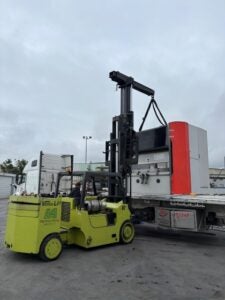
10 Important Steps for an Industrial Plant Relocation
1. Start with Clear Goals and a Realistic Timeline
Every great move starts with a clear purpose. Defining the key goals for your industrial plant relocation is essential for success. Are you relocating to expand operations, improve cost efficiency, or better align with strategic partners? Once your objectives are crystal clear, establish a timeline that accounts for each major phase – preparing the new facility, transferring equipment, restarting production, and scaling back to full capacity. Build in some extra time to handle the small challenges that often arise during a complex factory relocation process.
2. Catalog Your Assets In a Detailed Inventory
Every successful industrial plant relocation starts with clarity, and detailed documentation of your assets sets a crystal-clear starting line. Catalog every asset being relocated – production machinery, tools, IT systems, and office furnishings – along with their dimensions, weight, and power requirements. Don’t overlook raw materials, in-progress goods, or finished products in storage, as these are just as critical to track. By accounting for all these elements, you’ll set the foundation for an organized transition that leaves no asset behind.
3. Plot Your Plant’s New Location
A little foresight now can save a lot of scrambling later. Create a detailed map of your new facility to pinpoint exactly where each asset will go. It’s easy to underestimate how much effort unplanned decisions at the site can take. Focus on positioning major equipment, but don’t ignore smaller items – they matter, too. This careful mapping process will make your manufacturing plant relocation smoother and give you a clearer path to operational success.
4. Tap into Your Team’s Hands-On Expertise
Your workforce is the backbone of a successful manufacturing plant relocation. The individuals who operate and maintain equipment daily hold a wealth of knowledge that can streamline the process. Collaborate with them to develop a detailed plan for safely preparing and moving critical assets. Incorporate their recommendations early to prevent last-minute surprises and ensure everything is ready on time. Their expertise is invaluable for making the move as efficient as possible.
5. Draft Specific Instructions for Contractors
Handing off tasks to contractors and third-party service providers during a plant relocation will be a game-changer, but only if they know exactly what to do. Create detailed, no-nonsense instructions that outline their responsibilities step by step. This guidance should be simple and easy to reference, especially when supervising employees are pulled away or unavailable. Clear communication keeps everyone on the same page and the relocation on track.
6. Prepare the Path for Your Assets
Getting assets from point A to point B during a plant relocation is more than just loading trucks. From stationery and administrative tools to heavy machinery and high-risk materials, every asset’s exact route throughout the move should be mapped out inside and out. Will oversized items need wider openings or floor protection? Check for necessary permits if public roads are part of the plan. Preparing for these logistical details ahead of time helps avoid hiccups and keeps your facility relocation running according to plan.
7. Handle Hazardous Substances with Care
Dealing with dangerous materials isn’t something you want to take lightly when moving your business. If hazardous substances are part of your move, knowing their properties and handling them correctly is crucial. Ensuring safety means working with experts who understand hazmat protocols and have the tools to transport these items securely. A professional relocation team experienced in this area can help make the process smooth, efficient, and compliant with regulations, giving you one less thing to stress over.
8. Coordinate With Utility Providers
Timing is everything during plant relocation, especially when it comes to keeping your utilities flowing uninterrupted. If power, water, or other services need to be disconnected or activated, make sure they’re ready to go at your new location by coordinating with your service providers early on in the process. Avoid delays by scheduling these changes well in advance so operations resume without a hitch at your facility’s new location.
9. Perform Post-Move Inspections & Safety Reviews
You’re almost there, but before operations fully pick up in your new space, it’s vitally important to conduct thorough equipment inspections and safety reviews. Inspect and test relocated equipment to confirm everything is functioning correctly and safely. Walk through workflows with your team, conduct trial runs, and compare results to previous benchmarks to ensure processes are on track. Use this time to troubleshoot and fine-tune anything that needs adjustment. Plant relocation success depends on making sure safety training, certifications, and approvals are all in place before ramping up to full production.
10. Partner With a Skilled Factory Relocation Company
Why go it alone when experts are ready to make your plant relocation seamless? Partnering with a full-service factory relocation company means gaining a trusted ally with years of hands-on experience and a proven track record of success. Industrial moving professionals will handle all the complexities with ease and ensure every detail is expertly managed. With professional factory relocation services, you also benefit from comprehensive guidance throughout the process. Get a clear quote upfront, then lean on their expertise to simplify and streamline every phase of your move.
Success Lies in Strategic Execution
Relocating your factory might feel overwhelming, but with the right partner, it doesn’t have to be. LA Machinery Moving offers a complete suite of factory relocation services that prioritize efficiency and precision every step of the way. From secure crating, packaging, and short-term storage to heavy equipment shipping and expert reinstallation, we are your comprehensive source to keep your relocation project on time and on budget. Trust our skilled team to handle your move seamlessly. Contact us today to schedule your free estimate and get started.
-
Reasons Why Rigger’s Liability Insurance Is Important
Heavy equipment, high-risk environments, and complex operations are all in a day’s work for riggers. With so much at stake, having the right safety measures in place goes beyond the basics. Riggers’ liability insurance is a vital safeguard for operations that involve lifting, moving, or hoisting heavy loads. It’s there to help safeguard businesses, workers, and property against unexpected incidents.
Whether you’re tackling challenging projects or managing day-to-day tasks, this essential coverage ensures you’re prepared for the risks that come with the job. Knowing why it’s so important is the key to keeping your operations secure and moving forward. Let’s explore why riggers’ liability coverage is a must and what this means for you.

Liability insurance on a wooden table with glasses.
What Is Riggers Liability Insurance?
Handling heavy equipment and machinery you don’t own comes with serious responsibilities, especially when precision and safety are on the line. Riggers’ liability insurance steps in to address the unique risks of transporting or hoisting heavy equipment at the worksite. For example, if machinery is damaged during a lift, rigging insurance helps cover the costs, ensuring you’re not stuck footing the bill. Unlike general liability coverage, riggers’ insurance policies specifically protect property in our possession, both during transport and installation. Ultimately, riggers’ liability coverage, complemented by crane insurance, is an essential safety net that keeps your business prepared for the unexpected.
The Key Risks Covered by Riggers’ Liability Insurance
Hoisting and transporting valuable equipment is no small feat, and mistakes can be costly. That’s where riggers’ liability insurance offers essential protections when handling expensive machinery or materials. Here are four critical risks this coverage addresses to keep projects moving forward without unnecessary setbacks:
- Covers Property Damage – Riggers insurance ensures the cost of repairs or replacements is covered if equipment or property is damaged during a lift.
- Minimizes Project Disruptions – By providing coverage when incidents occur, you’ll help prevent delays that could otherwise stall an entire project timeline.
- Offers Customizable Coverage Options – From one-time projects to annual coverage, riggers insurance adapts to operational demands seamlessly and effectively.
Top Reasons Riggers’ Liability Insurance Is Essential
Handling heavy loads and operating complex machinery comes with significant responsibility. Riggers perform critical work that requires precision, skill, and a mindful approach to safety. While accidents can be rare, the costs of unforeseen incidents can escalate quickly, and proper planning is essential to keep operations running smoothly. That’s where riggers’ insurance plays a pivotal role for both our crew and our clients. Rigging coverage ensures your business is prepared for a variety of potential risks. Here are some primary ways rigger’s insurance safeguards your operations:
- Operator Coverage – Riggers often work in environments that pose physical dangers. Insurance supports operator safety by covering injuries, lost income, and liability risks.
- Compliance Coverage – Regulations are strict in this industry. Insurance helps protect against penalties if equipment inadvertently causes a state law or pollution violation.
- Equipment Coverage – Heavy machinery is vital to your work. Rigger’s insurance ensures that damaged or malfunctioning equipment can be repaired or replaced without disrupting operations.
- Coverage for the Public – Accidents that impact clients or bystanders can be costly. Insurance protects against property damage claims and public liability incidents.
What Could Go Wrong Without Rigger’s Liability Coverage?
Riggers and crane operators are constantly exposed to high-stakes scenarios on the job site, where accidents can happen faster than you think. Without rigging and crane rental insurance, an equipment failure could lead to expensive property damage or even serious injuries that halt progress entirely. A lifting mishap, for example, might damage expensive materials or structures, leaving you with a hefty repair bill. Public liability incidents can also escalate quickly, straining your business financially. Whether hoisting construction beams, installing HVAC systems, positioning large turbines, or transporting sensitive medical equipment, the right coverage ensures these moments don’t derail your operations or your reputation.
Common Misconceptions About Riggers Insurance
It’s easy to misunderstand what rigging liability insurance covers, especially with so many coverage options out there. A common misconception is assuming standard commercial general liability (CGL) policies offer automatic coverage for equipment or property belonging to others in your care, custody, or control. The truth is, CGL policies often exclude this, but a riggers liability endorsement can help fill the gap. However, it’s important to note that this endorsement may not extend to property or goods during transit.
Protect Your Los Angeles Business With LA Machinery Moving
Big challenges call for experts who make it look effortless. At LA Machinery Moving, we set the gold standard for heavy equipment moving services across the Greater Los Angeles area. From commercial to industrial projects, our experienced team handles every aspect of your operation with precision and care. With a focus on safety and thorough planning, we ensure your equipment is transported and installed seamlessly. Plus, with rigging liability insurance integrated into our services, you can trust us to cover all bases. Contact us today to get started on your next move.
-
Guide for Forklift Transportation and Moving
Your Comprehensive Guide to Forklift Transportation & Moving
Moving a forklift isn’t something most businesses tackle every day, but when it’s time, doing it right matters. Forklifts are powerful machines built to handle heavy loads, but getting one safely from point A to point B requires a thoughtful approach and the right expertise.
Professional forklift transport ensures your equipment arrives safely and stays in peak condition, whether you’re relocating it across town, over state lines, or halfway around the globe. Our comprehensive guide will walk you through everything you need to know to seamlessly move and relocate this heavy yet essential commercial piece of equipment.
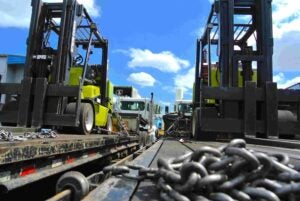
When Do You Need Forklift Transportation Services?
Moving industrial equipment like forklifts can be trickier than it seems. So, when should you call in the pros? Whether you’re planning to streamline your operations, upgrade your facility, or just need to move your equipment over a long distance, it’s smart to rely on professionals who specialize in forklift transport services. A heavy equipment moving company like LA Machinery Moving knows exactly how to handle the logistics safely and efficiently, ultimately saving you time, effort, and the risk of potentially damaging your machinery.
Partnering with forklift transportation experts means your equipment will arrive at its destination ready for action without the headaches – and substantial safety hazards – of figuring it out on your own.
Key Considerations Before Transporting a Forklift
Transporting a forklift to a new location isn’t as simple as loading it up and driving away. Moving heavy equipment is a multifaceted process that demands thoughtful planning and serious attention to detail. Overlook one small factor, and things can quickly spiral into unmanageable chaos. That’s why it’s critical to know what needs to be considered and accounted for before relocating a forklift.
- Forklift Specifications – Knowing your forklift’s exact dimensions, weight, and type is essential for a smooth move. The transport equipment used to move the forklift must align with these specifications, and movers with forklift expertise will rely on this data to ensure the process is seamless and safe.
- Regulations and Permits – Transporting forklifts often involves adhering to local, state, and federal regulations. Depending on the route and machinery size, special permits may be required. Heavy equipment moving professionals ensure no critical legislative details are missed during the process.
- Safety Precautions – Moving heavy machinery inevitably comes with risks. Properly trained personnel must oversee the loading process, with safety equipment like personal protective gear and wheel blocks securely in place. Avoiding accidents starts by preparing meticulously and prioritizing everyone’s safety.
- Transport Vehicle and Equipment – The type of flatbed trailer or truck matters. There must be no question about the vehicle’s ability to bear the forklift’s weight. Loading these machines requires the right ramps, tie-downs, and securement tools to keep everything steady during the trip.
- Route Planning and Timing – The transit route should be planned for efficiency and thoughtfully pre-determined to steer clear of tight corners, weight restrictions, and narrow roadways. Heavy equipment moving companies account for anticipated travel times to avoid potential delays or logistical complications.
Transport Methods for Forklifts
There are several ways to transport forklifts, but which one works best for hauling your machinery? Depending on the size, weight, and route distance, here are four commonly used options:
Flatbed Truck
A flatbed truck offers substantial space and a high weight capacity, making it suitable for transporting one or more forklifts. It features a low deck for easy loading and avoids clearance issues on the road. This truck type is particularly useful for long-distance transportation.
Tow Trailer
A tow trailer is a cost-efficient option for transporting forklifts over short to medium distances, but it must have sufficient weight capacity to hold the forklift. Once verified, the forklift can be driven onto the trailer and firmly secured with straps or chains to prevent movement during transit.
Tilt Tray Truck
Due to its tilt tray bed, a tilt tray truck makes loading and unloading forklifts smooth and straightforward. This type of transport is excellent for managing multiple forklifts at the same time, depending on size, and can easily handle medium-haul distances.
Automated Tailgate
An automated tailgate provides the largest capacity of all options, making it ideal for transporting heavy-duty or multiple forklifts. This method keeps everything safe and stable by allowing for more controlled loading and unloading, particularly for large-scale operations that demand absolute precision.
Getting a Forklift Transport-Ready
Getting a forklift ready for transport requires a careful preparation process and safety precautions along the way:
- Determine the Forklift’s Weight and Dimensions – Calculate the weight and measurements of the forklift to confirm compatibility with your trailer or transport vehicle. This step prevents mismatches and ensures a solid foundation for safe transport.
- Inspect the Forklift for Functionality and Safety – Conduct a thorough inspection of the forklift to confirm it is fully operational. Secure wheel chocks to stabilize the forklift and avoid any potential movement during loading.
- Lower and Position the Forks Properly – Lower the forks to the floor and tilt them to a slight forward angle. This positioning improves stability and prevents any unexpected shifts during transit.
- Secure the Forklift on the Trailer – Use blocks or wedges behind each wheel and secure them with fasteners to the trailer’s flooring. This action locks the forklift in place, adding another layer of safety.
- Power Down and Prepare Fuel Systems – Shut off the fuel supply by disconnecting the propane tank or tightening the fuel cap for gasoline or diesel models. Disconnect the battery terminal to avoid electrical issues during transport.
- Fasten With Chains and Tie-Downs – Attach chains or come-alongs to the truck’s anchor points, ensuring all connections are tight and secure. This step prevents movement and keeps the forklift in place while on the road.
Common Forklift Moving Challenges and How to Avoid Them
Transporting forklifts comes with its own set of challenges, starting with the fact that specialized shipping for forklifts isn’t in high demand. This often makes it difficult to find carriers, ultimately driving up both the cost and availability. Fewer specialized carriers mean higher prices, especially when flatbed trucks are required for the job. Planning and researching available services can help you avoid last-minute headaches and keep shipping costs manageable.
Another common obstacle involves the sheer size and weight of forklifts, which require careful consideration for loading and unloading. To ensure everything runs smoothly, it’s important to utilize proper equipment like ramps or cranes to simplify the process. Preparing ahead for each stage of transport minimizes delays and ensures forklifts are handled with care at every step.
Choosing the Right Forklift Transport Partner
Taking all the above into account can feel overwhelming without proper experience – a single overlooked detail can throw the entire operation off course. That’s why partnering with skilled movers with heavy machinery moving experience makes all the difference, saving you time, energy, and unnecessary headaches. Whether it’s speed and cost or security and peace of mind, the right method for completing your forklift transport project ultimately depends on your top priorities. Here are some of the main factors to weigh as you decide:
- Look at their experience with transporting heavy machinery, especially forklifts.
- Confirm they have the equipment necessary for safe handling, including specialized trailers and loading tools like ramps.
- Make sure they have the proper licenses and insurance to safeguard your shipment.
- Check their reputation and track record for safety by reviewing customer feedback.
- Discuss transit times and delivery options to ensure your schedule aligns with their services.
Make Forklift Transport Stress-Free With LA Machinery Moving
Moving a forklift doesn’t have to be complicated. At LA Machinery Moving, we specialize in full-service forklift transport solutions across the Greater Los Angeles area and beyond. If you need your forklift moved from one location to another, our team will provide a comprehensive plan of action, complete the project, and keep your assets safe. Whether moving your equipment across town or around the globe, request your free estimate today and see why we’re the renowned heavy equipment moving company you can trust from start to finish.
-
Guide for Moving Heavy Equipment & Machinery
Moving heavy equipment and machinery is a complex and critical task for many industrial businesses, requiring precision, expertise, and a thorough plan for success. Relocating factory machinery, industrial equipment, or other sizable assets in Los Angeles, is no small task due to the weight, dimensions, and transportation challenges involved. However, proper planning, the right tools, and experienced heavy equipment movers can make all the difference.
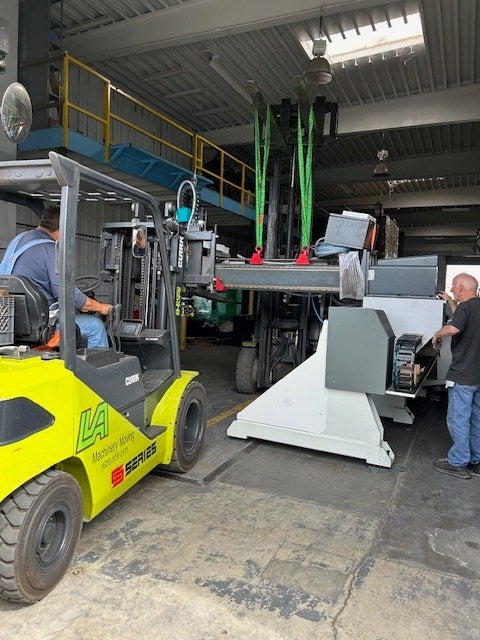
Why Moving Heavy Equipment Requires Expertise
Transporting heavy machinery is a real challenge—it demands significant preparation to mitigate safety risks, prevent damage, and comply with regulatory standards. Mishandling machinery or relying on inexperienced movers can result in accidents, financial losses, or lengthy project delays. Partnering with seasoned heavy equipment movers, like LA Machinery Moving, guarantees operations proceed efficiently and that your costly equipment is relocated safely.
Pre-Move Planning
Understand the Scope of the Job
Before moving, assess the machinery’s dimensions, weight, and the specifics required for its disassembly, if applicable. Consider potential challenges such as tight spaces, irregular terrain, or delicate components. Identifying such details early helps you plan a seamless move.
Create a Comprehensive Moving Plan
Preparation is everything. Outline a moving timeline, define roles and responsibilities, and confirm transportation methods that account for the equipment’s size and weight. If permits are necessary for oversized equipment, check that they are secured in advance to prevent delays.
Partner with Experts
For large-scale or technically complex tasks, hiring professional industrial machinery movers is key. Look for a company with decades of experience, like LA Machinery Moving, for client-centric services and security.
Safety Measures and Best Practices
Safety should always be paramount during a heavy equipment move. Below are some of the key measures and practices to follow:
- Perform Risk Assessments: Identify hazards, such as electrical disconnections, fluid leakages, or improperly secured components.
- Use Proper Lifting Techniques: Safety inspections and appropriate safety gear are essential to prevent workplace injuries.
- Communicate Clearly: All personnel involved should be briefed on the process. Use clear hand signals or proper communication tools during the operation.
When in doubt, turning to experienced professionals for a higher level of safety and oversight throughout the moving process.
Tools and Equipment for Moving Heavy Machinery
Using the right tools is paramount for transporting heavy machinery securely and effectively.
Essential Tools
The following are indispensable when relocating equipment:
- Heavy-duty machinery skates for smooth movement.
- Lever systems or pry bars to carefully lift machinery.
- Hydraulic jacks to elevate larger machinery securely.
Load-Securing Devices
Secure your machinery during transportation with the following tools:
- Heavy-duty chains and tie-down straps to anchor equipment in place.
- Reliable wheel chocks for equipment with wheels.
- Padding materials to reduce vibration or prevent abrasions.
Specialized Moving Equipment
The right moving equipment eases the most challenging aspects of relocation:
- Crane systems for lifting instruments to elevated heights.
- Forklifts for maneuvering heavy items into tight spaces.
- Air-ride suspension trucks for smooth and safe transport.
With 30 years of experience, LA Machinery Moving is equipped with state-of-the-art tools like cranes, forklifts, and custom flatbeds designed for various machinery tasks.
The Transportation Process
Transporting heavy equipment involves more than simply loading it onto a trailer. Here’s how the process typically unfolds:
- Pre-Load Inspections: Conduct thorough checks of the transport equipment for safety and functionality.
- Proper Loading: Machinery must be evenly distributed during loading to maintain balance and prevent tipping or shifting.
- Compliance with Regulations: For oversized or overweight machinery, secure permits and follow federal and state transportation regulations to avoid penalties.
- Route Planning: Plan a route that avoids obstacles like low underpasses, narrow roads, or steep inclines to ensure smooth transit.
Cost and Scheduling Considerations
Moving heavy machinery requires careful budgeting and scheduling to achieve your objectives and to control costs.
Cost Factors
Several factors can influence the cost of the move, including:
- Distance of the relocation.
- The size and weight of the machinery.
- Equipment and labor required to complete the task.
- Permitting and additional support vehicles, such as escort cars.
Scheduling Tips
Plan your move during off-peak hours to avoid traffic congestion or delays. Be realistic with deadlines to properly prepare and to secure transportation permits. A well-paced timeline reduces the likelihood of costly errors.
Why Hire Professional Heavy Equipment Movers?
Although some businesses may attempt to handle heavy machinery moves in-house, partnering with professionals like LA Machinery Moving offers distinct advantages.
- Safety and Expertise: Trained professionals know how to handle heavy machinery, ensuring its safety and that of your workforce.
- Specialized Equipment: Heavy equipment movers provide the advanced tools required to lift, secure, and safely transport machinery.
- Custom Logistics Solutions: Professional companies design their services to meet your particular requirements with flexible solutions.
- Peace of Mind: With experienced movers, you won’t have to worry about permits, regulations, or logistical concerns—everything is taken care of for you.
For over three decades, LA Machinery Moving has been the trusted choice for industrial businesses across Los Angeles. Our experienced team, world-class storage solutions, and unmatched commitment to customer satisfaction make us your go-to heavy equipment moving company.
Choose LA Machinery Moving for Your Next Equipment Move
Navigate the challenges of heavy machinery relocation with ease. Our qualified professionals can transform even the most complex equipment moves into safe, efficient, and stress-free experiences.
If you’re ready to move heavy equipment or industrial machinery, contact LA Machinery Moving—the industry leader in safe, efficient, and client-focused moving solutions. Contact us today at (626) 723-3218 to get a free estimate– we’re here to help you move with confidence.
-
How to Move Specialized Machinery
Relocating specialized machinery is a complex task that demands careful planning, technical expertise, and the right equipment. At LA Machinery Moving, we bring over 30 years of experience handling machinery and industrial equipment across Los Angeles. Our proven approach ensures your specialized manufacturing tools and heavy machinery are moved with precision, safety, and minimal downtime.

An Overview of Moving Specialized Machinery
Specialized machinery often represents a substantial investment and is vital to your business operations. Moving such equipment is not a task to be taken lightly. Improper handling can lead to costly damages, delays, or safety hazards. A successful move requires a clear strategy, a skilled team, and reliable tools to transport the machinery safely to its new location.
Tips for Safely Transporting Heavy Equipment
When it comes to moving heavy equipment, every detail matters. These tips will help make the process smoother and safer:
- Create a Detailed Strategy – Planning is essential for a seamless transition. Start by outlining each phase of the move, including equipment needs, timelines, and potential risks.
- Assemble the Right Team – Work with professionals experienced in moving specialized machinery. Their expertise is invaluable for overcoming challenges and ensuring the safety of your equipment.
- Disassemble with Precision – For larger machines, disassembly may be required. Each component should be carefully labeled and documented to simplify reassembly.
- Select Appropriate Tools – Use specialized transport equipment, such as cranes, forklifts, or rigging systems, designed to handle the weight and dimensions of your machinery.
- Perform a Site Evaluation – Visit the new location to assess space, access points, and potential obstacles. A site evaluation helps prevent surprises on moving day.
Focus on Safety Measures
Safety should always be the top priority when relocating heavy equipment. Here are key safety considerations:
- Use personal protective equipment (PPE) like helmets, gloves, and steel-toed boots.
- Provide clear communication among team members to prevent accidents.
- Follow industry-standard safety protocols to protect workers and equipment throughout the move.
Preparations Before Relocating Specialized Machinery
Proper preparation is critical to the success of your machinery relocation. Taking the time to plan every detail ensures the process goes smoothly:
- Find an Ideal New Location – Select a site that fits your machinery’s needs. The location should support operational efficiency while providing adequate space for maintenance and workflow.
- Verify the Space Has Enough Room – Accurate measurements are essential. Consider the footprint of your machinery and additional space required for workers, maintenance, and other equipment.
- Assess Employee Impacts – A machinery move can disrupt your team’s workflow. Keep employees informed about the process and plan for any temporary adjustments to minimize downtime.
- Calculate Equipment Weights – Knowing the weight of your machinery is essential for selecting appropriate tools and transport methods. Overestimating or underestimating weight can lead to delays or safety hazards.
Arrange Dependable Transport
Transporting specialized machinery requires reliable vehicles and equipment designed for heavy loads. At LA Machinery Moving, we use state-of-the-art specialized transport equipment to handle machinery of all sizes. Our vehicles and tools are tailored to the unique requirements of industrial equipment solutions, providing a safe and efficient relocation experience.
Advantages of Using Expert Transport Services
Hiring a professional machinery moving company offers significant benefits:
- Enhanced Safety – Experienced movers understand the complexities and risks associated with heavy equipment transport. Their knowledge helps prevent accidents and protects your valuable machinery.
- Prevention of Damages – Professional movers use specialized tools and techniques to handle machinery carefully, reducing the risk of damage during transport or reassembly.
- Improved Productivity – Outsourcing the move to experts allows your team to focus on core operations, minimizing disruptions and maintaining business productivity.
- Saving Time and Money – A professional mover’s efficiency reduces downtime and prevents costly mistakes, saving both time and resources in the long run.
Why Choose LA Machinery Moving?
At LA Machinery Moving, we understand the challenges of relocating specialized machinery. With decades of experience, we’ve perfected our process to prioritize safety, efficiency, and customer satisfaction. Our team uses the latest tools and techniques to handle even the most complex moves. Whether you’re relocating a single piece of equipment or an entire production line, we provide industrial equipment solutions you can trust.
Steps to a Successful Move
Our process begins with a comprehensive evaluation of your equipment and relocation needs. We create a detailed plan tailored to your project, assemble a skilled team, and use advanced tools to execute the move safely and efficiently. Visit our services page to learn more about how we can assist with your machinery relocation.
Final Thoughts
Relocating specialized machinery doesn’t have to be stressful. By partnering with experienced professionals, you can reduce risks, save time, and protect your investment. At LA Machinery Moving, we’re here to provide expert guidance and support for all your industrial equipment moving needs.
Are you ready to move your specialized machinery? Contact us today for a seamless relocation experience. Let us handle your move so you can focus on what matters most—running your business!
-
Safety Tips for Working Around Heavy Equipment
Operating and working around heavy equipment requires strict safety measures to avoid accidents and injuries. At LA Machinery Moving, we’ve spent over 30 years moving and handling industrial machinery, so we know how important it is to maintain safety standards. Whether you’re managing equipment vehicles or heavy machinery on-site, following these safety tips can protect both workers and equipment.
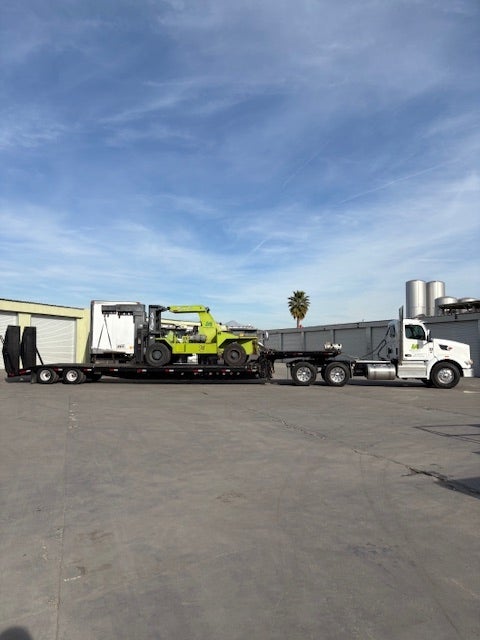
The Significance of Heavy Machinery Safety
Heavy equipment working environments can be hazardous without proper precautions. Accidents can result in serious injuries, delays, and financial losses. By prioritizing safety, you create a safer workspace for heavy equipment operators and others nearby.
Equipment Safety Tips
- Examine Equipment Before Use – Always inspect machinery before operation. Look for wear, leaks, or other signs of damage. Regular checks help identify problems early, keeping equipment safe and functional.
- Maintain Three-Point Contact – When climbing on or off heavy machinery, maintain three-point contact (two hands and one foot, or two feet and one hand) to prevent slips or falls.
- Wear a Seatbelt – Seatbelts aren’t just for cars; they’re essential when operating heavy equipment vehicles to prevent being thrown from the seat during sudden stops or uneven terrain.
- Be Alert to Blind Zones – Heavy equipment operators must stay aware of blind spots. Use mirrors and cameras to monitor surroundings and to make sure that no workers are in these dangerous zones.
- Understand Your Boundaries – Establish clear boundaries around operating equipment. Workers should maintain a safe distance and communicate effectively with operators when entering these areas.
Risks When Working Near Heavy Machinery
Working around heavy equipment involves multiple risks:
- Mechanical Risks – Moving parts can pose dangers if workers come into contact with them or if equipment malfunctions.
- Non-mechanical Dangers – Noise, vibration, and emissions can impact health over time without proper safeguards.
- Accessibility Risks – Limited access to controls or areas can lead to unsafe actions, especially during emergencies.
Safety Guidelines to Prevent Accidents
Preventing accidents starts with implementing safety-focused guidelines. Here are several steps to help reduce risks:
- Wear Protective Equipment – Personal protective equipment (PPE) like hard hats, gloves, goggles, and steel-toed boots provides critical protection against workplace hazards. High-visibility vests are also necessary in areas with moving equipment.
- Confirm Machines Are Safe – Before operating machinery, verify that it’s in proper working condition. Even minor malfunctions, like a loose bolt or a damaged hydraulic line, can lead to accidents if overlooked.
- Conduct Pre-use Inspections – Pre-use inspections should include checking brakes, lights, fluid levels, and tires. Using a checklist ensures that all key components are reviewed, keeping both operators and equipment safe.
- Carry Out Regular Maintenance – Routine maintenance is essential for preventing unexpected breakdowns. Schedule regular servicing to identify and repair wear and tear before it leads to equipment failure. This keeps machinery reliable and extends its lifespan.
- Stay Focused – Distractions can lead to mistakes, especially in high-risk environments. Operators should remain focused on their tasks, avoiding unnecessary conversations, phone use, or multitasking while working.
- Operate Equipment Only with Proper Training – Heavy machinery should only be operated by trained and certified personnel. Training ensures that operators understand equipment controls, safety protocols, and how to respond to emergencies.
- Keep the Work Area Clear – A cluttered workspace increases the risk of accidents. Remove debris, tools, or other unnecessary items from the area to allow operators to maneuver safely and efficiently.
LA Machinery Moving Prioritizes Safety
At LA Machinery Moving, we’ve built a reputation for safe, efficient equipment handling. Our team is highly trained in the latest safety protocols, and we use specialized tools to protect your machinery during every step of the move. With over three decades of experience in Los Angeles, we understand the unique challenges of heavy equipment relocation and work to eliminate risks wherever possible.
How We Support Your Business
We offer comprehensive moving services, from pre-move planning to equipment setup. Our commitment to safety and efficiency means that your machinery will arrive at its new location on time and in perfect condition. Visit our services page to learn more about how we can assist with your next move.
Summary
Safety is an ongoing effort in any workplace, especially when working with heavy machinery. Following these guidelines can help reduce risks, protect workers, and maintain a productive job site. For professional support, trust LA Machinery Moving to handle your heavy equipment with care and expertise.
Ready to move your heavy equipment safely? Reach out to LA Machinery Moving to learn more about our services. Fill out our contact form or give us a call to speak with a member of our experienced team. Let us help you create a safer and more efficient workplace!
-
Benefits of Hiring Professional Machinery Movers
Relocating heavy equipment or machinery is a complex task that requires skill, precision, and the right tools. At LA Machinery Moving, we bring over 30 years of expertise to every job, ensuring safe, efficient, and reliable equipment relocation for businesses across Los Angeles.
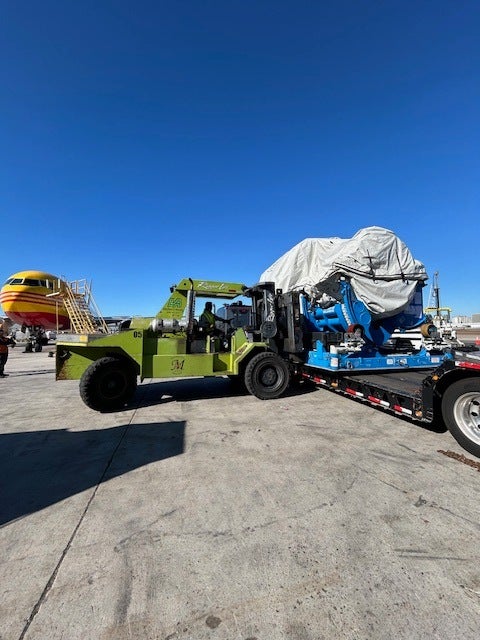
Expert Equipment Relocators
Professional machinery movers like LA Machinery Moving specialize in transporting heavy equipment and industrial machinery. Our trained staff understands the unique challenges of each move, offering solutions tailored to your specific needs. Whether it’s a single machine or an entire production line, we’ve got you covered.
Advantages of Hiring a Commercial Moving Company
Partnering with a commercial equipment mover offers numerous advantages, including safety, efficiency, and peace of mind. A professional team takes care of everything from planning to execution, letting you focus on your business while we handle the logistics.
Knowledge and Skill
Our experienced team brings in-depth knowledge to every move. With years of training, we know how to handle heavy machinery safely and efficiently, reducing the risk of damage to your equipment.
Dedicated Tools
Professional movers use specialized equipment designed for heavy machinery transport. At LA Machinery Moving, we utilize tools like cranes, rigging systems, and custom trailers to ensure your machines are moved securely and without incident.
Security
Protecting your valuable equipment is a top priority. Our team uses secure loading techniques, heavy-duty straps, and padding to prevent damage during transit. You can trust us to handle your machinery with care.
Minimized Downtime
Time is money, and we understand how important it is to minimize disruptions. Our efficient processes ensure that your machinery is relocated quickly so you can resume operations as soon as possible.
Hazard Prevention
Moving heavy machinery without the right expertise can lead to accidents, injuries, or equipment damage. Our team follows strict safety protocols to protect your assets, facility, and workers during the move.
Budget-Friendly
While hiring professional movers might seem like an upfront expense, it saves money in the long run. DIY moves often result in equipment damage, delays, and unexpected costs. Our streamlined processes and expertise ensure a cost-effective solution.
Insurance Coverage
Even with meticulous planning, accidents can happen. That’s why LA Machinery Moving provides comprehensive insurance coverage, giving you peace of mind knowing your equipment is protected throughout the move.
What Are the Risks of Moving Equipment Without Experts?
Attempting to move heavy machinery without the help of professionals can result in a range of issues. The equipment could get damaged, your facility could suffer property damage, and there’s also a higher risk of injury to those involved. Additionally, improper moves can cause delays and lost productivity as you work to fix issues that could have been avoided with professional help.
How to Select the Top Professional Moving Company for Machinery Moving
Choosing the right machinery moving company is essential for a successful move. Here are a few factors to keep in mind when making your decision:
- Experience – Look for a company with years of experience in machinery moving, like LA Machinery Moving.
- Reputation – Check reviews and testimonials to look for a proven track record.
- Specialized Tools – A top company should have the right equipment to handle your specific machinery.
- Safety Protocols – Make sure they follow strict safety guidelines to protect both your equipment and workers.
What Defines an Experienced Machinery Moving Company?
An experienced machinery moving company like LA Machinery Moving is one that not only knows how to safely transport equipment but also understands the logistics involved in moving it efficiently. From obtaining permits to navigating tricky routes, we handle all the details to ensure a smooth, safe move. With over 30 years in the industry, our knowledge and expertise allow us to anticipate potential challenges and address them before they arise.
Hire Professional Machinery Movers
When it comes to moving heavy equipment, hiring professionals is always the best option. Here at LA Machinery Moving, we provide the expertise, equipment, and security you need to move your industrial machinery safely and on time. Trust our team to handle your move with precision and care.
If you’re ready to make your machinery move easy and hassle-free, reach out to us today! Fill out our contact form or give us a call to speak with one of our expert team members. We’re here to help!
-
5S Warehousing: 5S Method to Create a Lean Warehouse
Our Lean Warehouse Management Practices in Los Angeles, CA
In fast-paced environments, efficiency is non-negotiable. Leveraging the transformative power of the 5S methodology for lean warehouse management, LA Machinery Moving has mastered the art of optimized operational productivity, safety, and compliance. Discover how our sustainable efforts contribute to a higher degree of quality service in Los Angeles, CA.

Heavy Equipment Moving & Industrial Warehousing Solutions
With over 100 years of combined experience, LA Machinery Moving is Los Angeles, CA’s leading choice for heavy equipment moving and industrial warehousing solutions. We specialize in a range of services for diverse industries and applications across Southern California. Blending seasoned expertise and personalized guidance, trust our experts for value-adding, heavy-equipment solutions.
How L. A. Machinery Moving Established a Lean Warehouse
L. A. Machinery Moving adopted the lean warehouse concept to boost productivity, reduce waste, and foster smoother, more streamlined operations. To achieve and sustain an efficient work environment, we employed the 5S method. The 5S methodology is a lean warehouse management practice rooted in five proven pillars of operational success.
How We Applied the 5S Lean Warehouse Method
The 5S lean warehouse method is more effective than one-time cleaning and organization efforts. This concept required our facility to commit to a complete workplace culture shift. This systematic and multifaceted approach fostered immediate productivity improvements and greater discipline to help us sustain efficient warehouse management practices for long-term success.
Our Approach to Lean Warehouse Management
If you’re unfamiliar with the 5S methodology for lean warehouse management, LA Machinery Moving is here to share the path we took to optimize our operations. Originally developed in Japan, the 5S technique is defined by five core strategies, including:
- Seiri (sort)
- Seiton (set in order)
- Seiso (shine)
- Seiketsu (standardize)
- Shisuke (sustain)
A Path Towards Efficiency & Productivity
To effectively adopt the 5S methodology for lean warehouse management, the foundational elements of the concept must be applied in the established order. While this technique can be used in numerous operational settings, LA Machinery Moving is here to highlight how we applied this technique to our facility.
Step One: Sort
The first phase of our lean warehousing transition involved sorting through our inventory to identify items that were most valuable to our operations and those that could be removed. We carefully labeled different categories of items and created holding spaces for unclassified items to yield a cohesive and uniform work environment.
Step Two: Set in Order
After removing obsolete materials, we moved on to phase two: setting our facility in order. We strategically implemented effective storage systems featuring designated sections and visual cues for easy identification and navigation. This allowed for a space-saving, ergonomic design that benefits both our employees and the customers who rely on us for efficient storage solutions.
Step Three: Shine
Organization is vital. However, a clean workspace is equally as crucial. That’s why phase three of our lean warehousing shift included a full sanitization and cleaning protocol. This allowed us to refine our space from floor to ceiling to ensure machinery and storage items remain safeguarded in our facility.
Step Four: Standardize
With a focus on sustainability, we applied a standardization practice to maintain the improvements garnered through the previous steps. L. A. Machinery Moving solidified these effective efforts by implanting visual management cues, floor and wall markings, and functional workspace guidelines. This promotes seamless navigation for both our employees and visitors.
Step Five: Sustain
The fifth and final step in our lean warehouse transformation is ongoing and refers to our sustainability practices. At L A Machinery Moving, we reinforce leadership roles and prioritize continuous employee training and education to maintain a disciplined, organized, and clean workplace. We also undergo periodic audits to monitor the effectiveness of our efforts, facilitating applicable improvements.
Optimize Your Improvements with LA Machinery Moving
LA Machinery Moving’s lean warehouse concept enables us to provide an elevated level of service. Defined by unmatched organization and productivity, our company sets the standard for equipment removal, relocation, and industrial storage solutions. Having mastered the art of operational efficiency, our professionals are equipped to expedite your heavy equipment storage demands with ease.
Get Started with Industrial Storage & Relocation Solutions in Los Angeles, CA
Trust in a company synonymous with organization to maximize the efficiency of your industrial storage and relocation needs. From heavy equipment moving to safeguarding heavy-duty equipment during transitional periods, look to LA Machinery Moving. To learn more or get started, contact our experts today.
-
10 Tips for Heavy Machinery Storage
Do you need to store heavy machinery like excavators, cranes, forklifts, or bulldozers? Prioritizing proper storage extends your equipment’s lifespan and ensures easy accessibility the next time you need it. Whether you’re storing machinery between jobs or preparing for a long off-season, the right preparation can save you from costly downtime and repairs when you retrieve the equipment from storage. Here are some tips to help you safely store your heavy machinery.
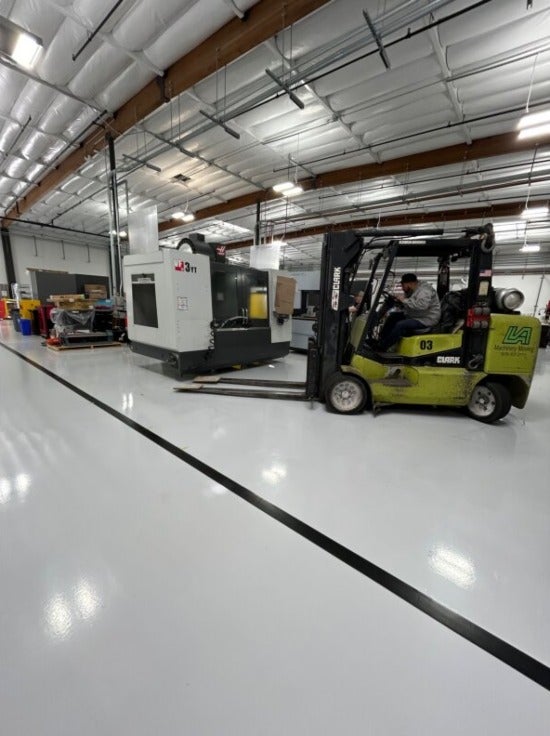
1. Check the Manufacturer’s Storage Recommendations
Before preparing your equipment for storage, review the manual to ensure you’re following the manufacturer’s best practices. If you don’t have a physical manual, check the website or call customer support. You may learn important details about fluid levels, battery care, and tire pressure. Some manufacturers may also recommend certain covers or specify conditions for short- vs. long-term storage.
2. Clean the Equipment
In preparation for storing your heavy machinery, clean it thoroughly to remove dirt, grease, and debris. Dirt can cause corrosion, while grease and grime buildup may lead to operational issues when you put the equipment back into use. Pressure washes the machinery, paying close attention to hard-to-reach areas where debris may accumulate. Let the equipment dry completely to prevent residual moisture from causing rust during storage.
3. Inspect for Repairs
Once the machinery is clean, perform a detailed inspection for existing damage or wear. Address issues like hydraulic leaks, worn belts, or loose bolts to prevent more significant damage from developing during storage. Conducting repairs beforehand also ensures that the equipment is in working order when you need it.
4. Lubricate Moving Parts
Lubrication prevents friction and rust while your equipment sits idle. Apply the recommended lubricant to all joints, bearings, and pivot points to create a protective moisture barrier. This is especially important for equipment with many moving parts, like excavators and cranes.
5. Change Fluids and Add Stabilizers
For machinery with engines, changing the oil and fluids before storage prevents contamination and engine damage. Be sure to top off the coolant and hydraulic fluid to avoid freezing or corrosion in the system. If you’re storing equipment for a few months or longer, add a fuel stabilizer to the tank to prevent fuel degradation. Run the engine briefly after adding the stabilizer to allow it to circulate through the system.
6. Remove or Disconnect the Battery
If your equipment won’t be used for an extended period, it’s wise to remove the battery and store it separately in a cool, dry place. Disconnecting the battery prevents it from slowly draining over time and extends its life. If removing the battery isn’t practical, at least disconnect it to avoid drainage or electrical issues.
7. Protect Electronics and Sensitive Components
Heavy machinery often contains electronic components, such as GPS systems, control panels, and sensors, which are vulnerable to moisture, dust, and extreme temperatures. Shield these components during storage by using protective covers, or remove detachable electronics and store them separately in a safe, dry place.
8. Inflate and Protect the Tires
If your machinery uses tires, inflate them slightly above the manufacturer’s recommended pressure. Properly inflated tires prevent flat spots and damage from long periods of inactivity. If possible, elevate the equipment slightly using blocks to take the weight off the tires and further reduce the risk of damage.
9. Plan Regular Inspections
Check on your equipment periodically while it’s in storage. Visual inspections every few months ensure no new issues have developed. Verify that protective coverings remain in place, moisture hasn’t accumulated, and there are no signs of pest infestations or structural damage. Maintain a detailed record of your inspections, repairs, and other activities related to your equipment while in storage. This log provides valuable information about your machinery’s condition when it’s time to retrieve it.
10. Store Indoors When Possible
Storing your heavy equipment indoors is ideal, as this protects it from the sun, rain, humidity, and other environmental factors. Prolonged exposure to UV rays can damage rubber components, while moisture can cause metal areas to rust. If you have the option, storing in a climate-controlled facility is an excellent investment in maintaining your machinery’s condition. If indoor storage isn’t available, cover the machinery with heavy-duty tarps and park it on a solid surface to avoid sinking or uneven wear.
Safe, Secure Machinery Storage in Los Angeles
LA Machinery Moving offers over 100,000 square feet of general storage and 40,000 square feet of climate-controlled warehouse space in Los Angeles, perfect for keeping your heavy equipment in peak condition. Our facilities protect your machinery from weather, vandalism, and other factors that can cause damage during storage. In addition to short- and long-term storage solutions, we provide loading, unloading, crating exporting, and packing services for your convenience. Contact us today to find a storage solution that fits your needs and budget.
-
Hygiene & Medical Equipment Relocation
Hospitals, research clinics, and testing laboratories must sometimes transport oversized machinery within the same building or to a new facility. This complex process demands expertise and attention to detail. Working with a professional medical equipment transportation service ensures your critical devices are relocated safely, quickly, and in compliance with healthcare standards. Whether you’re moving a single piece, or an entire department, proper planning and specialized handling are essential for a successful move.
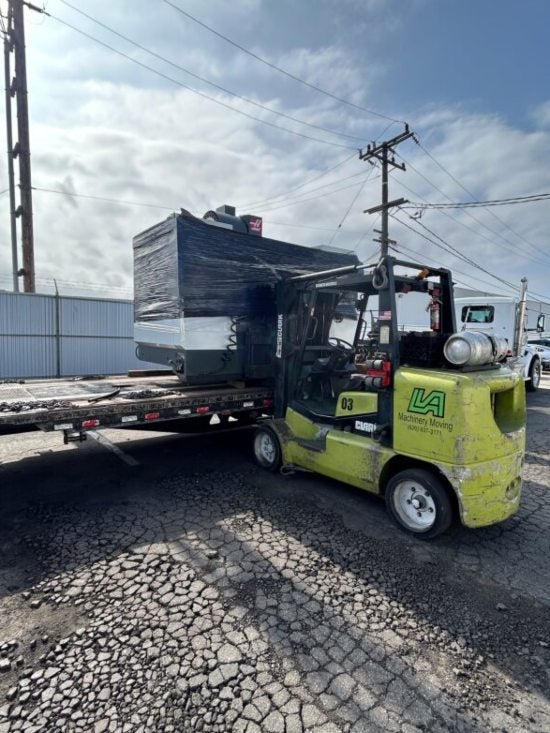
Challenges in Medical Equipment Relocation
Medical equipment transportation poses several unique challenges. Each must be addressed to ensure a safe, efficient move without damaging the equipment or disrupting patient care.
Equipment Safety
Medical devices are often expensive and fragile. They require careful handling to prevent damage during transport. Each piece must be secured using custom crates or skids and cushioned to withstand vibrations and shocks that may occur during loading, unloading, and transportation.
Minimizing Downtime
In the medical industry, downtime can negatively impact patient care and hospital operations. A crucial part of moving medical equipment is to reduce the time that equipment is out of use. Careful coordination and pre-planning ensure the transition goes as smoothly and quickly as possible.
Adherence to Healthcare Rules
Medical equipment transportation must follow strict healthcare regulations, including sterilization standards and hazardous materials guidelines. Working with an experienced medical equipment transportation company ensures that all legal and safety requirements are met.
Custom Packaging
When moving medical equipment, one size doesn’t fit all. Different devices require unique packaging, such as moisture-proof bagging, anti-static materials, or cushioning. These solutions protect sensitive electronics and prevent environmental factors like dust, moisture, and vibrations from affecting the equipment during transport.
Commonly Transported Medical Equipment
Medical equipment transportation solutions are available for a wide range of devices. Here are some of the most commonly transported items:
CT scanners are large, fragile machines requiring careful dismantling and packaging before transportation. Their size and sensitivity make them challenging to move, necessitating a partnership with experienced medical equipment movers.
MRI machines are bulky and sensitive to movement. They also contain powerful magnets that must be properly handled to avoid damage during relocation.
X-ray devices are another example of large, sensitive equipment that demands precise handling and transportation.
Diagnostic equipment like ultrasound machines and ECG units may need to be relocated during hospital renovations or layout reconfigurations. Careful transport reduces the risk of damage to sensitive components.
Lab equipment, such as microscopes and incubators, often contain delicate parts that can be easily damaged by improper handling or environmental exposure. They require custom crating and packaging.
Lasers used in various medical procedures are delicate and expensive. They must be secured with vibration protection during transport.
Surgical instruments are often made of specialized materials and must be kept sterile throughout the relocation process. Custom crating and moisture-proof packaging are frequently used to protect these items.
Hospital furniture isn’t as delicate as medical equipment, but hospital beds, stretchers, and medical carts should be securely packed and transported to avoid damage.
Steps for Transporting Medical Equipment
Successful hospital & medical equipment transportation requires a clear, step-by-step process. Follow these best practices to ensure each piece of equipment is moved efficiently and safely.
Planning
First, create a detailed plan for the move. This includes evaluating the equipment to be relocated, identifying the need for custom crating or climate control, and setting a timeline that minimizes downtime for your medical facility.
Dismantling
Large medical devices, such as MRI machines or CT scanners, must often be partially dismantled before transport. This requires a team of experts who understand the equipment they’re working with to avoid causing damage.
Loading
Proper loading techniques are crucial to ensure equipment safety during transport. Machinery should be loaded using specialized lifts and secured with straps, cushioning, and bracing to prevent movement.
Transportation
This phase calls for moving the machinery with suitable transportation equipment, such as cranes, trucks, trailers, or climate-controlled vans, depending on the requirements of what’s being relocated. For instance, some machines need temperature or humidity regulation to maintain their integrity, while this precaution is unnecessary in other cases.
Reassembly
Once the equipment reaches its destination, it must be reassembled and tested to ensure proper functionality. This process should be handled by trained professionals who understand the equipment’s technical specifications.
Trust Us for Medical Equipment Relocation in Los Angeles
LA Machinery Moving specializes in relocating medical equipment, drawing from over 30 years of industry experience. Our knowledgeable team ensures secure and efficient transport for sensitive medical devices. We offer personalized services that span the entire transportation process for minimal downtime and complete safety. Contact us today to request a quote for medical equipment transportation services in Los Angeles, CA.
